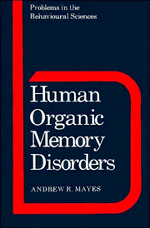Book contents
- Frontmatter
- Contents
- Acknowledgements
- 1 Healthy and pathological memory: the underlying mechanisms
- 2 The assessment of memory disorders
- 3 Disorders of short-term memory
- 4 Disorders of previously well-established memory
- 5 The memory problems caused by frontal lobe lesions
- 6 Organic amnesia
- 7 Animal and biochemical models of amnesia
- 8 Less well-characterized memory disorders
- 9 Overview
- Glossary
- Bibliography
- Index
3 - Disorders of short-term memory
Published online by Cambridge University Press: 01 June 2011
- Frontmatter
- Contents
- Acknowledgements
- 1 Healthy and pathological memory: the underlying mechanisms
- 2 The assessment of memory disorders
- 3 Disorders of short-term memory
- 4 Disorders of previously well-established memory
- 5 The memory problems caused by frontal lobe lesions
- 6 Organic amnesia
- 7 Animal and biochemical models of amnesia
- 8 Less well-characterized memory disorders
- 9 Overview
- Glossary
- Bibliography
- Index
Summary
Normal people forget some information in a few seconds but remember other things for years. It is widely believed that the information that is forgotten in seconds has been held in a limited-capacity short-term store and has not been transferred to a more stable, large-capacity long-term store. Of course, forgetting is a continuous process, and normal people forget things after seconds, minutes, hours, days, weeks, months, and years, but researchers do not propose that there are hundreds of stores to cover all these delays. Indeed, most workers believe that one kind of memory store is sufficient to explain all forgetting that occurs with delays of more than a few seconds. So why is belief in a separate kind of short-term store from which information is lost in seconds so widespread? As discussed in chapter 1, there are now psychologists, such as Wickelgren (1974), who argue that all the phenomena of rapid forgetting can be explained in terms of the properties of a single storage system. The evidence, based on studies of normal people, that immediate memory is affected differently from longer term memory by such variables as type of encoding and learning time can just as easily be interpreted in terms of a single storage hypothesis as it can in terms of the existence of separate short- and long-term stores. The short-term-storage hypothesis probably derives its appeal from two factors. First, rapid forgetting is something of which we are all very aware and distinguish from stable, long-term memory, which gives plausibility to the feeling that there is a discontinuity between rapid and slower kinds of forgetting.
- Type
- Chapter
- Information
- Human Organic Memory Disorders , pp. 55 - 75Publisher: Cambridge University PressPrint publication year: 1988



